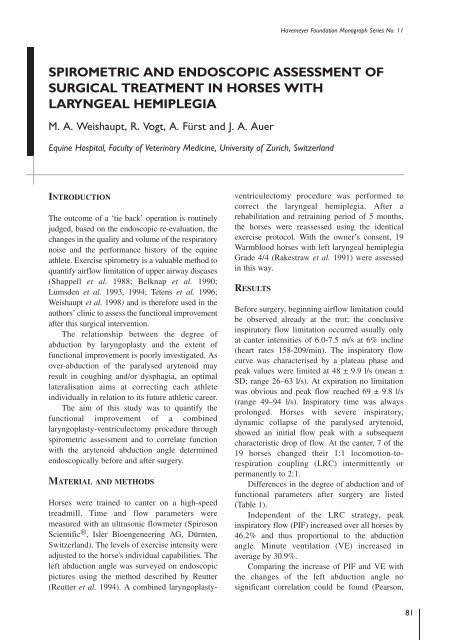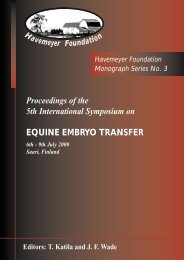Proceedings of a Workshop on - The Havemeyer Foundation
Proceedings of a Workshop on - The Havemeyer Foundation
Proceedings of a Workshop on - The Havemeyer Foundation
Create successful ePaper yourself
Turn your PDF publications into a flip-book with our unique Google optimized e-Paper software.
<strong>Havemeyer</strong> Foundati<strong>on</strong> M<strong>on</strong>ograph Series No. 11<br />
SPIROMETRIC AND ENDOSCOPIC ASSESSMENT OF<br />
SURGICAL TREATMENT IN HORSES WITH<br />
LARYNGEAL HEMIPLEGIA<br />
M. A. Weishaupt, R. Vogt, A. Fürst and J. A. Auer<br />
Equine Hospital, Faculty <str<strong>on</strong>g>of</str<strong>on</strong>g> Veterinary Medicine, University <str<strong>on</strong>g>of</str<strong>on</strong>g> Zurich, Switzerland<br />
INTRODUCTION<br />
<strong>The</strong> outcome <str<strong>on</strong>g>of</str<strong>on</strong>g> a ‘tie back’ operati<strong>on</strong> is routinely<br />
judged, based <strong>on</strong> the endoscopic re-evaluati<strong>on</strong>, the<br />
changes in the quality and volume <str<strong>on</strong>g>of</str<strong>on</strong>g> the respiratory<br />
noise and the performance history <str<strong>on</strong>g>of</str<strong>on</strong>g> the equine<br />
athlete. Exercise spirometry is a valuable method to<br />
quantify airflow limitati<strong>on</strong> <str<strong>on</strong>g>of</str<strong>on</strong>g> upper airway diseases<br />
(Shappell et al. 1988; Belknap et al. 1990;<br />
Lumsden et al. 1993, 1994; Tetens et al. 1996;<br />
Weishaupt et al. 1998) and is therefore used in the<br />
authors’ clinic to assess the functi<strong>on</strong>al improvement<br />
after this surgical interventi<strong>on</strong>.<br />
<strong>The</strong> relati<strong>on</strong>ship between the degree <str<strong>on</strong>g>of</str<strong>on</strong>g><br />
abducti<strong>on</strong> by laryngoplasty and the extent <str<strong>on</strong>g>of</str<strong>on</strong>g><br />
functi<strong>on</strong>al improvement is poorly investigated. As<br />
over-abducti<strong>on</strong> <str<strong>on</strong>g>of</str<strong>on</strong>g> the paralysed arytenoid may<br />
result in coughing and/or dysphagia, an optimal<br />
lateralisati<strong>on</strong> aims at correcting each athlete<br />
individually in relati<strong>on</strong> to its future athletic career.<br />
<strong>The</strong> aim <str<strong>on</strong>g>of</str<strong>on</strong>g> this study was to quantify the<br />
functi<strong>on</strong>al improvement <str<strong>on</strong>g>of</str<strong>on</strong>g> a combined<br />
laryngoplasty-ventriculectomy procedure through<br />
spirometric assessment and to correlate functi<strong>on</strong><br />
with the arytenoid abducti<strong>on</strong> angle determined<br />
endoscopically before and after surgery.<br />
MATERIAL AND METHODS<br />
Horses were trained to canter <strong>on</strong> a high-speed<br />
treadmill. Time and flow parameters were<br />
measured with an ultras<strong>on</strong>ic flowmeter (Spiros<strong>on</strong><br />
Scientific ® , Isler Bioengeneering AG, Dürnten,<br />
Switzerland). <strong>The</strong> levels <str<strong>on</strong>g>of</str<strong>on</strong>g> exercise intensity were<br />
adjusted to the horse's individual capabilities. <strong>The</strong><br />
left abducti<strong>on</strong> angle was surveyed <strong>on</strong> endoscopic<br />
pictures using the method described by Reutter<br />
(Reutter et al. 1994). A combined laryngoplastyventriculectomy<br />
procedure was performed to<br />
correct the laryngeal hemiplegia. After a<br />
rehabilitati<strong>on</strong> and retraining period <str<strong>on</strong>g>of</str<strong>on</strong>g> 5 m<strong>on</strong>ths,<br />
the horses were reassessed using the identical<br />
exercise protocol. With the owner’s c<strong>on</strong>sent, 19<br />
Warmblood horses with left laryngeal hemiplegia<br />
Grade 4/4 (Rakestraw et al. 1991) were assessed<br />
in this way.<br />
RESULTS<br />
Before surgery, beginning airflow limitati<strong>on</strong> could<br />
be observed already at the trot; the c<strong>on</strong>clusive<br />
inspiratory flow limitati<strong>on</strong> occurred usually <strong>on</strong>ly<br />
at canter intensities <str<strong>on</strong>g>of</str<strong>on</strong>g> 6.0-7.5 m/s at 6% incline<br />
(heart rates 158-209/min). <strong>The</strong> inspiratory flow<br />
curve was characterised by a plateau phase and<br />
peak values were limited at 48 ± 9.9 l/s (mean ±<br />
SD; range 26–63 l/s). At expirati<strong>on</strong> no limitati<strong>on</strong><br />
was obvious and peak flow reached 69 ± 9.8 l/s<br />
(range 49–94 l/s). Inspiratory time was always<br />
prol<strong>on</strong>ged. Horses with severe inspiratory,<br />
dynamic collapse <str<strong>on</strong>g>of</str<strong>on</strong>g> the paralysed arytenoid,<br />
showed an initial flow peak with a subsequent<br />
characteristic drop <str<strong>on</strong>g>of</str<strong>on</strong>g> flow. At the canter, 7 <str<strong>on</strong>g>of</str<strong>on</strong>g> the<br />
19 horses changed their 1:1 locomoti<strong>on</strong>-torespirati<strong>on</strong><br />
coupling (LRC) intermittently or<br />
permanently to 2:1.<br />
Differences in the degree <str<strong>on</strong>g>of</str<strong>on</strong>g> abducti<strong>on</strong> and <str<strong>on</strong>g>of</str<strong>on</strong>g><br />
functi<strong>on</strong>al parameters after surgery are listed<br />
(Table 1).<br />
Independent <str<strong>on</strong>g>of</str<strong>on</strong>g> the LRC strategy, peak<br />
inspiratory flow (PIF) increased over all horses by<br />
46.2% and thus proporti<strong>on</strong>al to the abducti<strong>on</strong><br />
angle. Minute ventilati<strong>on</strong> (VE) increased in<br />
average by 30.9%.<br />
Comparing the increase <str<strong>on</strong>g>of</str<strong>on</strong>g> PIF and VE with<br />
the changes <str<strong>on</strong>g>of</str<strong>on</strong>g> the left abducti<strong>on</strong> angle no<br />
significant correlati<strong>on</strong> could be found (Pears<strong>on</strong>,<br />
81








